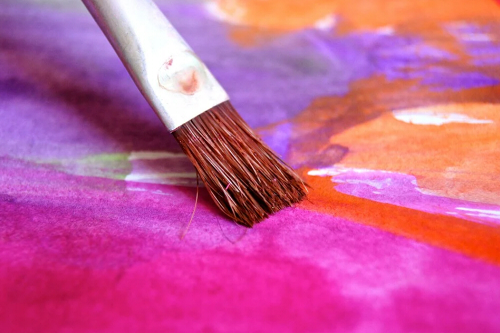China Academy of Art Teaches Students to ‘Reinvent Its Heritage’
中国美院鼓励学生“重塑传统”
This spring the usual 100,000 or so applicants vying for just 1,700 places at one of China’s most prestigious art colleges were not squeezing into vast halls for the gruelling four-day entrance exam. Instead, as a result of the Covid pandemic, the China Academy of Art hopefuls found the whole process had been moved online.
每年通常约有10万名申请人角逐中国最负盛名的艺术院校之一的1700个名额,但今年春天,他们没有在巨大的考场参加为期四天的紧张的入学考试。由于新冠疫情,中国美术学院(China Academy of Art)的申请者发现整个过程转移到了网上。
All the CAA’s courses, which include fine art, ceramics, architecture and fashion, are wildly oversubscribed and for those wishing to study jewellery, there are just 20 places on the undergraduate course and a handful for the masters degree. The jewellery course also attracts international students from around the world.
中国美术学院所有课程——包括美术、陶瓷、建筑设计和时尚——的申请人数都远远超过名额,对于那些希望学习珠宝首饰设计的人来说,本科只有20个名额,硕士学位只有几个名额。珠宝课程也吸引了来自世界各地的国际学生。
The CAA was founded in 1928, but the jewellery department is just 10 years old. Its evolution reflects a desire to rediscover and celebrate traditional Chinese culture while building a bridge to the modern world and serving a soaring consumer market.
中国美术学院成立于1928年,但珠宝首饰设计专业才成立10年。它的演变反映一种渴望:重新发现和庆祝中国传统文化,同时建立一座通向现代世界的桥梁,并为飙升的消费市场服务。
“We want to teach students how to use traditional techniques in a contemporary way but also keep a global view on what is happening in the international scene,” says Zhenghong Wang, vice-dean of the college of crafts and head of the jewellery school at the CAA. “Chinese culture is the key point of our programme. Every class is linked with a tradition – even the basic technical classes are linked with a cultural background.”
中国美术学院手工艺术学院副院长、首饰与金工专业学科带头人汪正虹表示:“我们希望教会学生如何以当代的方式使用传统技法,同时对国际舞台上发生的事情保持全球视野。中国文化是我们课程的重点。每一堂课都与一种传统相联系——甚至基础技法课也与一种文化背景相联系。”
This includes teaching the enamelling technique of cloisonné as well as metal folding – both are practised by a dwindling number of craftspeople in the country. Ms Wang is also keen to teach the jewellery-making traditions of China’s minorities in the west and south of the country.
这包括教授景泰蓝的珐琅工艺和金属折叠——中国会这两种工艺的工匠越来越少。汪正虹还热衷于教授中国西部和南部少数民族的传统珠宝制作工艺。
It is a challenging undertaking, particularly given that China is “starting from zero” when it comes to building a contemporary jewellery sector. This is the opinion of Ruudt Peters, one of the Netherlands’, and Europe’s, most eminent artist-jewellers. He has a close relationship with the CAA’s jewellery studio, which he has visited many times to teach.
这是一项具有挑战性的任务,尤其是考虑到中国正在“从零开始”建设当代珠宝行业。这是荷兰乃至欧洲首屈一指的珠宝艺术家鲁德·得斯(Ruudt Peters)的观点。他与中国美术学院的珠宝首饰工作室有着密切的关系,曾多次去那里讲课。

“In fine art there are some really intriguing artists who have found their own identity based in their Chinese roots,” he says. “In jewellery I feel there is still a missing link. Their teachers have been sent to Europe to get their training, then they come back and coach students to become good westernised jewellers.”
“在美术领域,有一些很有意思的艺术家,他们基于自己的中国根源找到了自己的身份认同。”他说。“在珠宝领域,我觉得还有一个缺失的环节。他们的老师被派往欧洲接受培训,然后他们回来指导学生成为优秀的西方化珠宝艺术家。”
But Mr Peters also sees work that he much admires and even finds “heartbreaking”. He recently curated a jewellery exhibition sponsored by the CAA, and first shown in Hangzhou in 2018, called 21 Grams. It showed works by 160 jewellers, split evenly between those from the west and China. The pieces were made in response to the name of the show, which refers to the amount of weight lost by a human body at the moment of death. This was observed by a US doctor in the early 1900s and was interpreted to represent the weight of the soul. Each piece of jewellery weighed 21 grammes.
但是彼得斯也看到了他非常欣赏、甚至觉得“令人心碎”的作品。他最近策划了一个由中国美术学院主办的珠宝展览,于2018年在杭州首次展出,名为“21克”(21 Grams)。它展示了160位珠宝艺术家的作品,来自西方和中国的作品各占一半。这些作品是根据该展览的名称制作的,每件展品重21克。据称一位美国医生在20世纪初观察到人在死亡瞬间体重会减轻21克。这被解释为灵魂的分量。
“21 Grams was a challenge and I am very happy the CAA allowed me to do it. But they were very afraid of the ghost of the soul,” says Mr Peters. “Some Chinese jewellers made strong work in the traditional way but brought it up to date. I loved those pieces. But some in China thought they were not good or relevant, only old-fashioned.”
“‘21克’是一个挑战,我很高兴中国美院允许我这样做。但他们非常害怕鬼魂。”彼得斯说。“一些中国珠宝艺术家用传统方式制作了精美的作品,但也与时俱进。我喜欢那些作品。但中国的一些人认为它们不好或不相关,太过老派了。”
For its part, the CAA jewellery studio is firm in its aims of teaching its students to reach into the past for inspiration and to teach them the skills to make their work by hand. The jewellery of the final-year students, displayed in their graduate show in June, was inspired by a field trip to the Buddhist caves of Dunhuang, in north-west China. The purpose of the trip was to study the cave paintings, which date back to the fourth century, and the local architecture.
就其本身而言,中国美术学院珠宝首饰工作室的目标是坚定的:教会学生从过去获取灵感,并向他们传授手工制作作品的技能。今年6月,大四学生设计的珠宝在他们的毕业展上展出,其灵感来自一次去中国西北部敦煌佛教洞穴的实地考察。这次旅行的目的是研究可以追溯到四世纪的石窟壁画和当地建筑。
Of those graduating students, typically almost half would continue their studies overseas, some would become teachers and a few would set up their own studio.
在这些即将毕业的学生中,通常有近一半人会前往海外继续学习,一些人会成为教师,还有一些人会建立自己的工作室。
Qian Zhongshu, a graduate of the CAA, first studied sculpture there. He now runs a successful jewellery studio in Hangzhou. He became fascinated by antique jewellery, and began collecting often broken pieces with little monetary value. He used his sculpture skills to redesign and embellish them, to “give old pieces new value and meaning”.
钱钟书是中国美术学院的毕业生,最初在那里学习雕塑。他现在在杭州经营着一家成功的珠宝工作室。他迷上了古代首饰,并开始收集往往没有多少货币价值的古董碎片。他用自己的雕塑技巧重新设计和修饰它们,“赋予旧作品新的价值和意义”。
“I aim to combine classic Chinese style with modern art. I love goldfish, butterflies, folding fans and moon-shaped fans, and I make a lot of jewellery pieces of them. They have become my signature work. I have attracted a celebrity following.”
“我的目标是将中国古典风格与现代艺术相结合。我喜欢金鱼、蝴蝶、折扇和月亮扇,我制作了很多以它们为灵感的珠宝首饰。它们已经成为我的标志性作品。我已经吸引了一批名人粉丝。”
英文、中文版本下载:http://www.yingyushijie.com/shop/source/detail/id/2577.html








